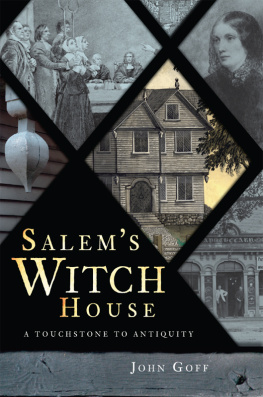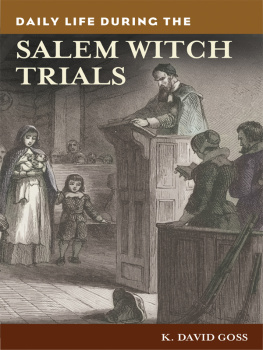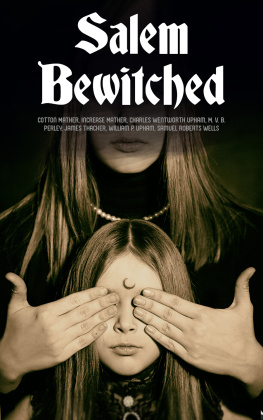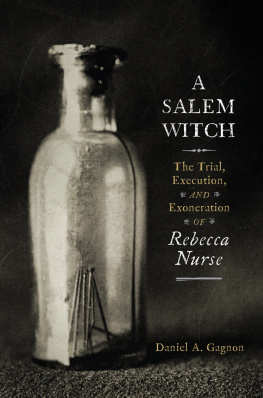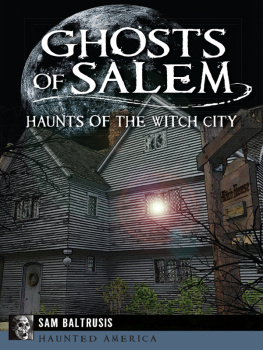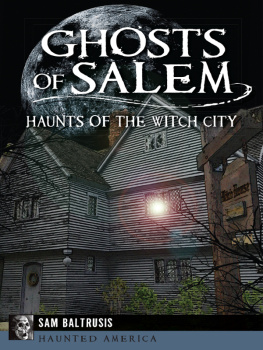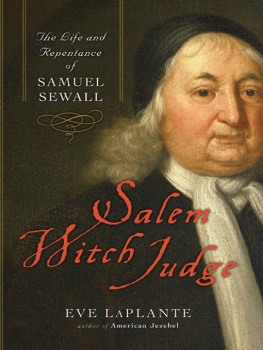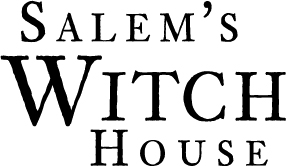

Salem Witch House door handle. Photograph by John Goff.

Published by The History Press
Charleston, SC 29403
www.historypress.net
Copyright 2009 by John Goff
All rights reserved
Cover image: Clark Goff sketch.
Cover design by Marshall Hudson
First published 2009
e-book edition 2012
ISBN 978.1.61423.286.5
Library of Congress Cataloging-in-Publication Data
Goff, John V.
Salems Witch House : a touchstone to antiquity / John Goff.
p. cm.
Includes bibliographical references.
print edition ISBN 978-1-59629-519-3
1. Witch House (Salem, Mass.)--History. 2. Dwellings--Massachusetts--Salem--History. 3. Historic buildings--Massachusetts--Salem. 4. Architecture, Domestic--Massachusetts--Salem--History. 5. Salem (Mass.)--Buildings, structures, etc. 6. Salem (Mass.)--History. 7. Dwellings--Conservation and restoration--Massachusetts--Salem--History. 8. Historic buildings--Conservation and restoration--Massachusetts--Salem. 9. Historic preservation--Massachusetts--Salem. 10. Salem (Mass.)--Biography. I. Title.
F74.S1G64 2009
974.45--dc22
2009033683
Notice: The information in this book is true and complete to the best of our knowledge. It is offered without guarantee on the part of the author or The History Press. The author and The History Press disclaim all liability in connection with the use of this book.
All rights reserved. No part of this book may be reproduced or transmitted in any form whatsoever without prior written permission from the publisher except in the case of brief quotations embodied in critical articles and reviews.
CONTENTS
AUTHORS NOTE

Salem Witch House pendant drop. Photograph by John Goff.
Because the ancient Witch House at the corner of Essex and North Streets in Salem, Massachusetts, evolved through many different ownership periods dominated by members of Salems Davenport, Corwin, Ward and other families, many different names have been and could be used to describe the house(s) erected there. Three houses in particular were all first built in proximity for Davenports, Corwins and Curwen kin: the Bowditch House, the Lindall-Gibbs House and the Davenport-Corwin or Corwin House, also known today as the Witch House. Throughout this book, we will refer to the Corwin House or Davenport-Corwin House as the Witch House, because the structure is so closely tied to and associated with the life and legacy of Judge Jonathan Corwin of the Salem witch trials of 1692.
ACKNOWLEDGEMENTS
Many people assisted in bringing this book into being. The author would like to thank Anna Kasabian, Rachel Roesler and Saunders Robinson with The History Press; Karen Gahagan; and many others. Bonnie Hurd Smith and Bob Booth provided information and inspiration. Jim McAllister, Kathy Simolaris, Elizabeth Seater and Sara Harwood all provided research assistance.
Judy Lazdowski provided help locating various rare Witch House antiques. Staley McDermet, Meg Twohey, Nat Bowditch, Becky Putnam, Ray Shea, Kate van Dyke and many associated with Historic Salem, Inc., provided help with the Bowditch House research and early study of the property.
The author and publishers are also indebted to many others, including but not limited to: Mayor Kim Driscoll of the City of Salem; Representative John Keenan, descendant of Rebecca Nurse, a 1692 witch trials victim; Lorraine Jackson and the staff of the Salem Public Library; Bill Finch and Donna Thorland; Doug Bollen; Biff Michaud and the staff of the Salem Witch Museum; Christine Michelini and the Peabody Essex Museum; Richard Trask; Polly Chase Harrell; John Hardy Wright; Stephen J. Shier; Annie C. Harris, Bill Steelman and the proponents of the First Period Preservation Initiative at the Essex National Heritage Commission; Earl Taylor, Ellen Berkland and fellow founders of the Alliance of First Period Properties in Dorchester and Boston, Massachusetts; the board members of Salem Preservation, Inc., preservers and restorers of Salem in 1630: Pioneer Village; Cliff Hersey, K. David Goss and Kristina Wacome Stevick with the Institute for Public History of Gordon College; and Abbott Lowell Cummings, First Period architectural historian. Thank you all!
INTRODUCTION
Salems ancient Witch House at Essex and North Streets is one of Americas most significant historic landmarks. It is also architecturally compelling and intriguing, due to its being so out of step with the twenty-first century. While all around it traffic rushes and people pass, the house itself sits like a silent memorial to and reminder of Salems earliest days.
Old houses and ancient properties guard secrets, for in many cases the oldest of the family records and memories have been lost or destroyed over the generations and years. Times change and people forget what happened. In the absence of recorded history, myth grows and mysteries multiply.
The primary purpose of this book is to begin the process of reconstructing and narrating the true and ancient history of the Salem Witch House property, while also using the house as a window through which to view Salems own evolution as a settlement site.
The Witch House in Salem, Massachusetts, is nationally significant for its ties to the Salem witch hysteria and trials of 1692, for its early restoration as a Colonial Revival historic house museum between about 1840 and the 1940s and also for the part it played as a backdrop property to Leslies Retreat, considered the first armed conflict in the Revolutionary War. In addition, the site itself also predates English settlement to connect with long-ago Naumkeag and a world created and occupied by Native Americans. It also has many ties to maritime Salem as a seaport.

The primal elements of First Period architecture are visible in this 1970 rendering of the Witch House, produced by the authors uncle. Courtesy of Clark M. Goff.
Salems Witch House has many surprising stories to tell. Here we will begin by sharing a few. But to hear them all, it is necessary to visit, view and experience this remarkable colonial and Colonial Revivalstyle landmark. Be sure to visit Salem and tour the house in person!
CHAPTER 1
ANCIENT BEGINNINGS
Before 1626
Salems wicked cool Witch House at the corner of Essex and North Streets stands on one of the oldest sites in North America. It is a seventeenth-century property that has deep roots in much older times. But why trust my testimony? Consider instead the ancient account provided by Salems scribe. Hear the words of Nathaniel Hawthorne, who descended from John Hathorne, the seventeenth-century witchcraft judge and the black-robed court companion and in-law of Jonathan Corwin.
Tucked tween the covers of his Twice-Told Tales, Hawthorne described the Salem spot that stands precisely three hundred paces east of Essex and North Streets, the place that anciently, like the Witch House site, bordered an old eastwest Indian trail.
Next page
